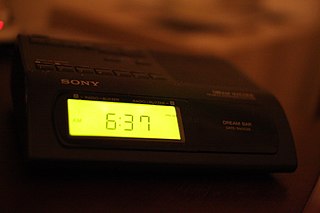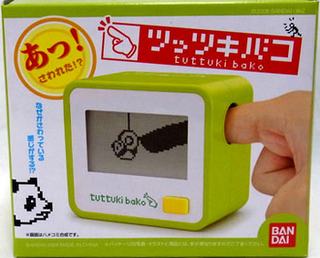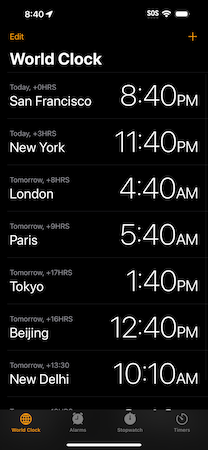
A computer mouse is a hand-held pointing device that detects two-dimensional motion relative to a surface. This motion is typically translated into the motion of the pointer on a display, which allows a smooth control of the graphical user interface of a computer.

In electronics, a remote control is an electronic device used to operate another device from a distance, usually wirelessly. In consumer electronics, a remote control can be used to operate devices such as a television set, DVD player or other digital home media appliance. A remote control can allow operation of devices that are out of convenient reach for direct operation of controls. They function best when used from a short distance. This is primarily a convenience feature for the user. In some cases, remote controls allow a person to operate a device that they otherwise would not be able to reach, as when a garage door opener is triggered from outside.
The year 1876 in science and technology involved some significant events, listed below.

Yoshiro Nakamatsu, also known as Dr. NakaMats, is a Japanese inventor. He regularly appears on Japanese talk shows demonstrating his inventions.
The year 1956 in science and technology involved some significant events, listed below.
A buzzer or beeper is an audio signaling device, which may be mechanical, electromechanical, or piezoelectric. Typical uses of buzzers and beepers include alarm devices, timers, train and confirmation of user input such as a mouse click or keystroke.

An alarm clock or alarm is a clock that is designed to alert an individual or group of people at a specified time. The primary function of these clocks is to awaken people from their night's sleep or short naps; they can sometimes be used for other reminders as well. Most alarm clocks make sounds; some make light or vibration. Some have sensors to identify when a person is in a light stage of sleep, in order to avoid waking someone who is deeply asleep, which causes tiredness, even if the person has had adequate sleep. To turn off the sound or light, a button or handle on the clock is pressed; most clocks automatically turn off the alarm if left unattended long enough. A classic analog alarm clock has an extra hand or inset dial that is used to show the time at which the alarm will ring. Alarm clock functions are also used in mobile phones, watches, and computers.

A striking clock is a clock that sounds the hours audibly on a bell, gong, or other audible device. In 12-hour striking, used most commonly in striking clocks today, the clock strikes once at 1:00 am, twice at 2:00 am, continuing in this way up to twelve times at 12:00 mid-day, then starts again, striking once at 1:00 pm, twice at 2:00 pm, up to twelve times at 12:00 midnight.

A digital clock displays the time digitally, as opposed to an analogue clock.
Amy Smith is an American inventor, educator, and founder of the MIT D-Lab and senior lecturer of mechanical engineering at MIT.

The Mosquito or Mosquito alarm is a machine used to deter loitering by emitting sound at high frequency. In some versions, it is intentionally tuned to be heard primarily by younger people. Nicknamed "Mosquito" for the buzzing sound it plays, the device is marketed as a safety and security tool for preventing youths from congregating in specific areas.
Marie Van Brittan Brown was an American nurse and innovator. In 1966, she invented a video home security system along with her husband Albert Brown, an electronics technician. That same year they applied for a patent for their security system. It was granted three years later in 1969. Her innovation impacted the security system. Brown was born in Jamaica, Queens, New York. She died there on February 2, 1999 at the age of seventy-six.

The iRiver Clix is a portable media player that was developed and sold by iriver through two generations. The Clix was originally known as the U10, released in 2005. The next year it was revised and essentially rebranded to Clix. A second generation player, often called the Clix 2, was released in 2007, and later a minor revision called Clix+. The players are navigated by four buttons embedded on its sides, referred to as D-Click.

The Casio F-91W is a digital watch manufactured by Japanese electronics company Casio. Introduced in June 1989 as a successor of the F-87W, it is popular for its low price and long battery life.

A talking clock is a timekeeping device that presents the time as sounds. It may present the time solely as sounds, such as a phone-based time service or a clock for the visually impaired, or may have a sound feature in addition to an analog or digital face.

Sony Dream Machine was Sony's long-running line of clock radios. The line was introduced in the early 1960s and ran until the early 2010's.

Tuttuki Bako (ツッツキバコ) is a roughly cubic hand-held electronic game created by Bandai in 2008. The game comprises five mini-games, and a resettable alarm clock. While the minigames are rather simplistic, Tuttuki Bako has received international acclaim for its unique means of control and the game has been put forward as an archetypal example of Akiba-kei and Japanese gadgetry in general.

Windows Clock is a time management app for Microsoft Windows, with five key features: alarms, world clocks, timers, a stopwatch, and focus sessions. The features are listed on a sidebar. The app is similar in functionality and design to the Clock app on iOS. Windows Clock was available on mobile devices for over a decade before it was available on PCs with the introduction of Windows 8.1. Tiles for alarms, timers, and the stopwatch can be pinned to the Start menu. The latest version of the app uses the Universal Windows Platform APIs and adopts Windows UI theme. Windows Clock is distinct from the Windows taskbar's clock, which has been part of Windows since 1995.

Clock is a timekeeping mobile app available since the initial launch of the iPhone and iPhone OS 1 in 2007, with a version later released for iPads with iOS 6, and Macs with the release of macOS Ventura. The app consists of a world clock, alarm, stopwatch, and timer.













